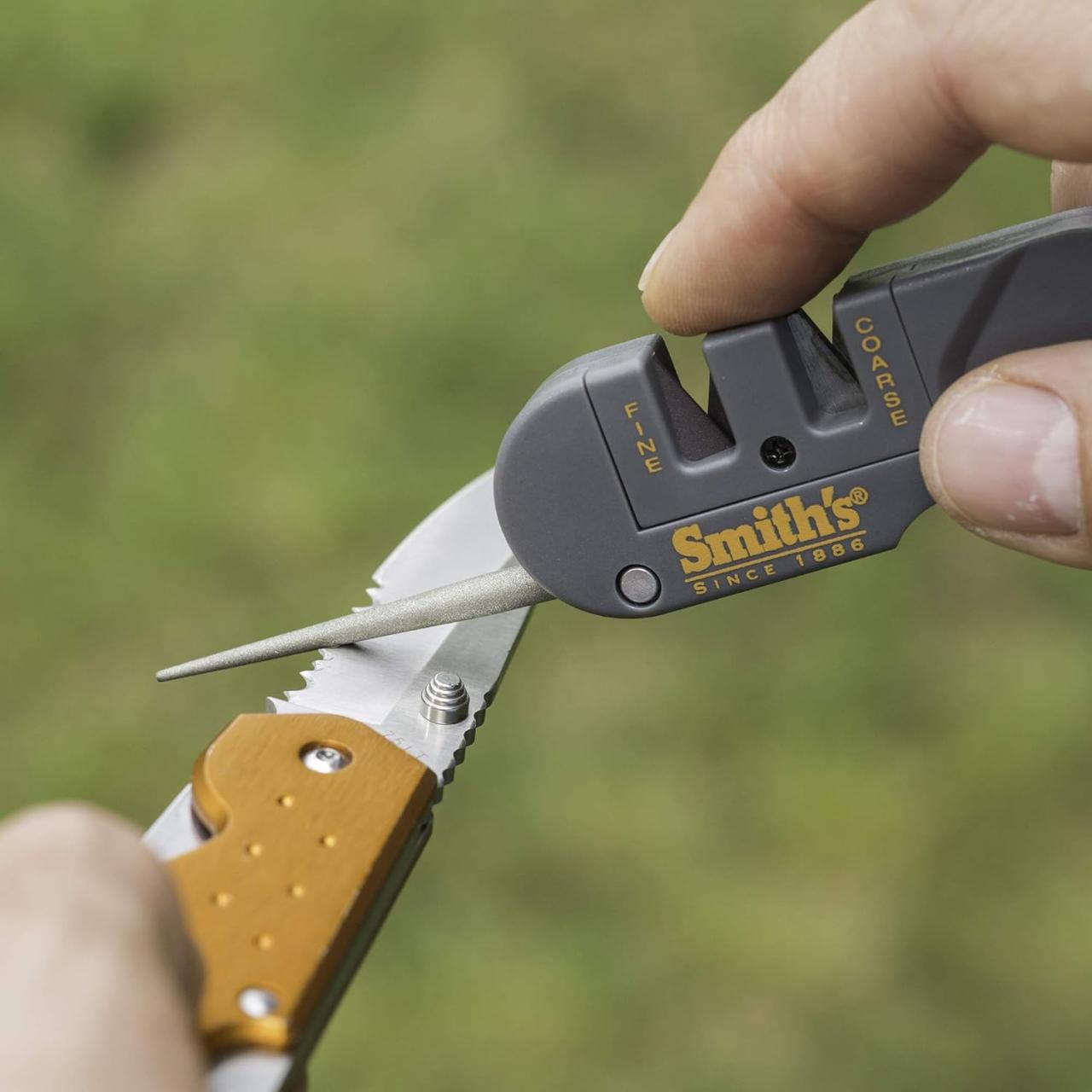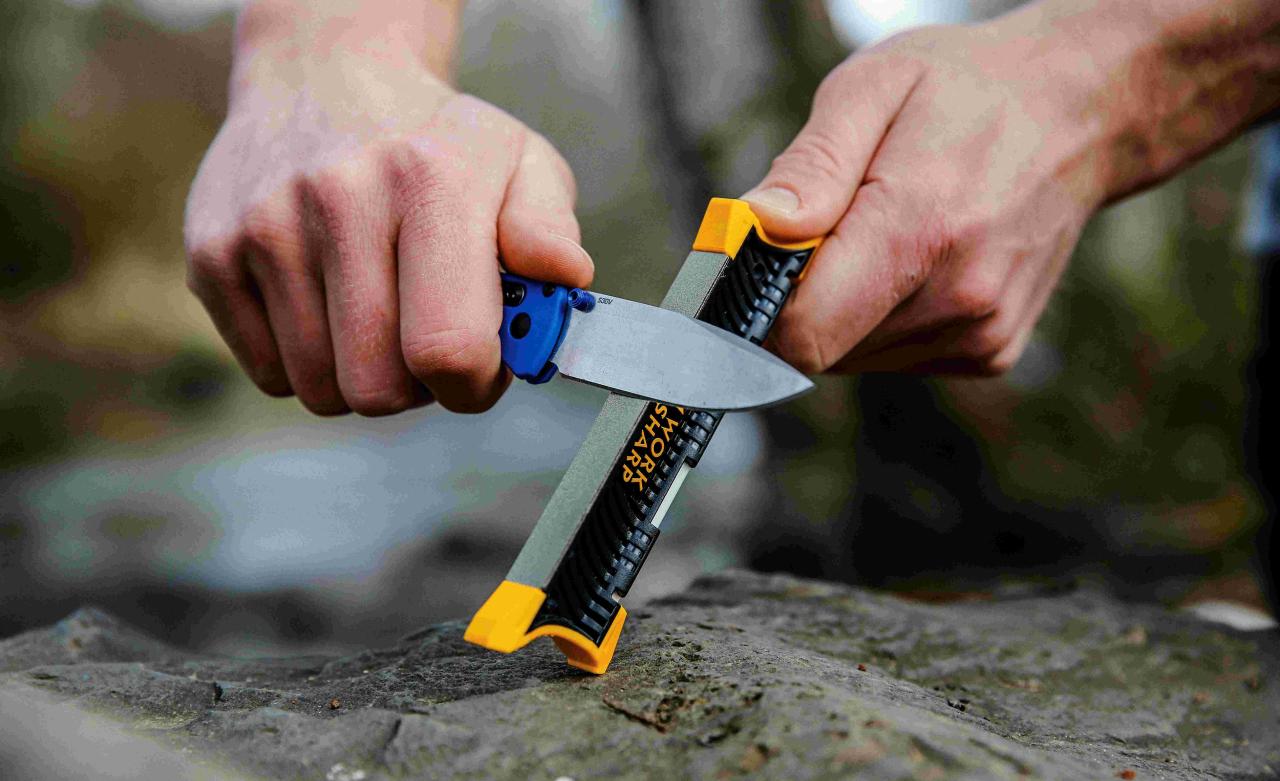Step into the world of precision and sharpness as we delve into the realm of pocket knife sharpeners. With their unparalleled ability to restore the keen edge of your trusted blades, these compact tools empower you to conquer any cutting task with ease and confidence.
Whether you’re a seasoned outdoorsman or simply seek to maintain the pristine condition of your everyday carry, understanding the nuances of pocket knife sharpeners is essential. Join us on this comprehensive journey as we unravel the secrets of these remarkable devices, ensuring your blades remain razor-sharp for years to come.
Pocket Knife Sharpener Types
Pocket knife sharpeners are available in various types, each designed to suit different needs and preferences. Understanding the distinctions between these types will help you choose the sharpener that best aligns with your requirements.
Manual vs. Electric
Manual sharpeners require physical effort to operate, while electric sharpeners use an electric motor to drive the sharpening mechanism. Manual sharpeners offer greater control and precision, but they can be more time-consuming. Electric sharpeners, on the other hand, are faster and more convenient, but they may not provide the same level of control.
Fixed-angle vs. Freehand
Fixed-angle sharpeners maintain a consistent sharpening angle throughout the process, ensuring even and accurate sharpening. Freehand sharpeners allow you to vary the sharpening angle, giving you more flexibility but also requiring more skill to use effectively.
Stone vs. Ceramic vs. Diamond
Sharpening stones are made from natural or synthetic materials, such as Arkansas stone or ceramic. Ceramic sharpeners are harder than stones and provide a finer edge, while diamond sharpeners are the hardest and most durable, offering the longest-lasting results.
Factors to Consider When Choosing a Pocket Knife Sharpener

Selecting the right pocket knife sharpener depends on several key factors. Understanding these considerations will help you choose the sharpener that best meets your specific needs and preferences.
Knife Blade Type
The type of knife blade you have determines the sharpener you need. Straight-edge blades are common on pocket knives and require a sharpener designed for flat surfaces. Serrated blades, on the other hand, have a saw-like edge and require a sharpener that can accommodate their unique shape.
Desired Sharpness Level
Consider the desired sharpness level for your knife. Different sharpeners offer varying degrees of sharpness, from a fine edge for precision cutting to a coarser edge for heavy-duty tasks. Choose a sharpener that can achieve the level of sharpness you need.
Portability and Ease of Use
If you plan on carrying your sharpener with you, portability is essential. Consider the size, weight, and overall design of the sharpener. Additionally, ease of use is important, especially if you’re not an experienced sharpener.
Maintaining your chainsaw is essential for optimal performance. An electric chainsaw sharpener can make the process quick and easy. By restoring your chain’s sharpness, you’ll improve cutting efficiency and extend its lifespan.
Budget and Value
Determine your budget for a pocket knife sharpener. There are a range of options available, from affordable to high-end models. Consider the features, quality, and durability of the sharpener in relation to its cost to ensure you get the best value for your money.
How to Use a Pocket Knife Sharpener

Using a pocket knife sharpener is a simple but effective way to keep your knives sharp and ready to use. By following a few simple steps, you can ensure that your knives are always performing at their best.
Safety Precautions
Before using a pocket knife sharpener, it is important to take a few safety precautions:
- Wear eye protection to avoid any debris from getting into your eyes.
- Be careful not to cut yourself on the knife blade.
- Use the sharpener on a stable surface to avoid any accidents.
Holding the Knife Correctly
When using a pocket knife sharpener, it is important to hold the knife correctly. This will help you achieve the best results and avoid any accidents.
The Garmin Forerunner 245 is an excellent choice for runners who want a waterproof watch with advanced features. It tracks your pace, distance, heart rate, and more, and it can even be used for swimming. If you’re looking for a chainsaw sharpener that will make your life easier, the electric chainsaw sharpener is a great option.
It’s easy to use and does a great job of sharpening your chainsaw.
- Hold the knife with your dominant hand, with the blade pointing away from you.
- Place your thumb on the spine of the blade, and your fingers on the handle.
- Keep your fingers away from the cutting edge of the blade.
Maintaining the Correct Angle, Pocket knife sharpener
The angle at which you hold the knife is critical when using a pocket knife sharpener. The correct angle will vary depending on the type of sharpener you are using, but it is generally around 20 degrees.
- To maintain the correct angle, place the sharpener on a flat surface and hold the knife at the desired angle.
- You can use a protractor to measure the angle if you are not sure.
- Once you have the correct angle, hold the knife steady and draw it through the sharpener.
Making Smooth, Consistent Strokes
When using a pocket knife sharpener, it is important to make smooth, consistent strokes. This will help you achieve a sharp edge and avoid damaging the knife blade.
- Draw the knife through the sharpener in one smooth motion.
- Do not press down too hard, as this can damage the blade.
- Continue drawing the knife through the sharpener until you have achieved the desired sharpness.
Maintenance and Care of Pocket Knife Sharpeners
To extend the lifespan of your pocket knife sharpener, proper maintenance and care are crucial. Regular cleaning, lubrication, stone flattening and replacement, as well as careful storage and transportation, are essential practices to ensure optimal performance and longevity.
Cleaning and Lubrication
Dirt, debris, and metal shavings can accumulate on your sharpener over time, hindering its efficiency. To prevent this, clean the sharpener regularly with a soft cloth or brush. For stubborn grime, use a mild detergent or rubbing alcohol. Lubricate moving parts, such as hinges or bearings, with a few drops of oil to ensure smooth operation.
If you’re looking for a reliable and waterproof smartwatch, the Garmin Forerunner 245 is an excellent choice. With its advanced features and rugged design, it’s perfect for athletes and outdoor enthusiasts alike.
Stone Flattening and Replacement
The sharpening stones on your sharpener can become uneven or worn with use. This can affect the sharpening angle and consistency. To maintain a flat sharpening surface, use a diamond flattening stone to level the stones periodically. If the stones become excessively worn or damaged, replace them with new ones to restore the sharpener’s effectiveness.
Storage and Transportation
When not in use, store your pocket knife sharpener in a dry, dust-free location. Protect it from extreme temperatures and moisture, as these can damage the materials and affect its performance. When transporting the sharpener, use a protective case or wrap it securely to prevent damage during transit.
Examples of Pocket Knife Sharpeners

There are various pocket knife sharpeners available, each with its own features and benefits. Here’s a table summarizing some examples:
| Sharpeners | Type | Angle | Material | Portability | Price |
|---|---|---|---|---|---|
| Lansky Turnbox | Fixed-angle | 17-25 degrees | Ceramic | Portable | $40-$60 |
| Spyderco Sharpmaker | Freehand | Adjustable | Ceramic/Diamond | Portable | $100-$150 |
| DMT Diafold | Fixed-angle | 15 degrees | Diamond | Compact | $50-$70 |
Epilogue
As we conclude our exploration of pocket knife sharpeners, it’s evident that these ingenious tools are indispensable companions for any knife enthusiast. Their ability to effortlessly restore the sharpness of your blades not only enhances their performance but also extends their lifespan, ensuring years of reliable service.
Whether you opt for a manual or electric model, fixed-angle or freehand design, the key to unlocking the full potential of your pocket knife sharpener lies in understanding its capabilities and using it with precision. Embrace the art of sharpening, and let your knives become extensions of your skill and craftsmanship.
Question & Answer Hub
What factors should I consider when choosing a pocket knife sharpener?
Consider the type of knife blade (straight edge or serrated), desired sharpness level, portability, ease of use, and budget.
How do I use a pocket knife sharpener effectively?
Follow safety precautions, hold the knife correctly, maintain the correct angle, and make smooth, consistent strokes.
What are the different types of pocket knife sharpeners?
Manual vs. electric, fixed-angle vs. freehand, and stone vs. ceramic vs. diamond.